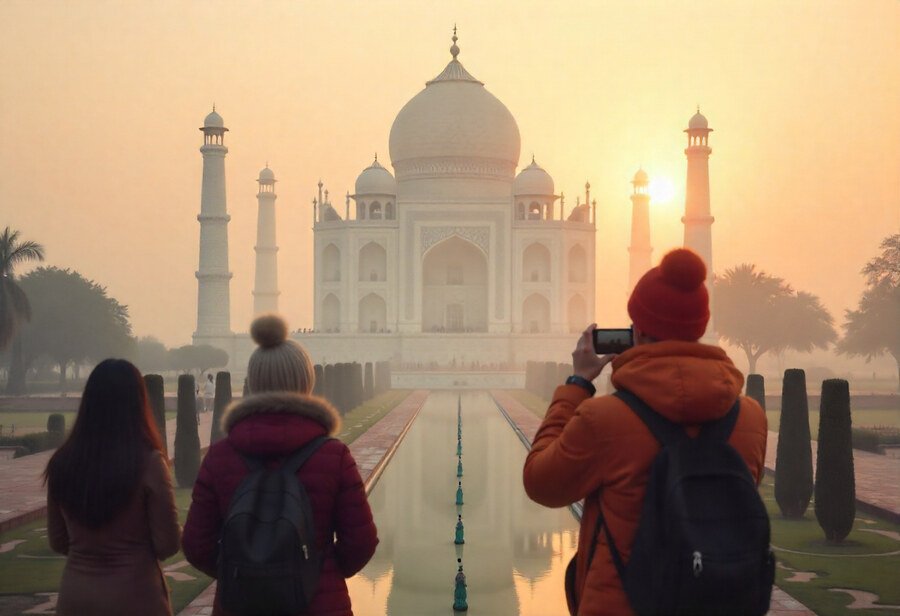Travel Guides & Articles
India Hits 99.52 Lakh Foreign Tourist Arrivals in 2024 but Must Improve Tourism Infrastructure to Unlock Its Full Potential and Compete with Leading Global Destinations

Published on
August 18, 2025
India’s tourism sector has seen a strong recovery in 2024, with foreign tourist arrivals (FTAs) reaching 99.52 lakh, surpassing pre-pandemic levels and signaling a revitalized industry. While the numbers are encouraging, the country faces ongoing challenges in achieving its full tourism potential, particularly when compared to smaller countries that attract higher volumes of international visitors.
A Remarkable Growth in Foreign Tourist Arrivals
- Total Foreign Tourist Arrivals (FTAs): 99.52 lakh
- Leading Source Markets: United States, Bangladesh, United Kingdom, Australia, Canada, Malaysia, Sri Lanka, Germany, France, and Singapore
- International Tourist Arrivals (ITAs): 205.69 lakh in 2024, showing an impressive rise from 63.37 lakh in 2020.
India’s tourism sector has shown an upward trajectory, with the United States and Bangladesh leading as primary sources of foreign visitors. The jump in FTAs from 27.45 lakh in 2020 to 99.52 lakh in 2024 reflects a steady recovery post-pandemic. Additionally, the surge in international tourist arrivals (ITAs) indicates the growing global interest in visiting India. However, concerns remain about India’s ability to attract as many international tourists as other countries with smaller populations.
Global Tourism Landscape: India vs. Competitors
India’s tourism performance, though positive, remains below expectations when compared to other countries. Despite a population of 1.4 billion and an abundance of cultural and natural resources, India continues to trail behind in attracting global tourists. For instance, Vietnam, a smaller country in terms of both size and population, welcomed over 17.6 million international tourists in 2024, far surpassing India’s foreign arrivals.
Major cities in Europe, like Paris, receive 25 million international visitors annually, far outstripping the 10 million tourists India attracts each year. This disparity raises questions about why India, with its rich historical, cultural, and natural heritage, isn’t tapping into its full tourism potential.
India boasts 42 UNESCO World Heritage Sites, more than many European countries, but its ability to attract foreign tourists remains limited. While India’s tourism infrastructure continues to improve, the country still struggles to compete with other nations that have made significant investments in promoting tourism.
Bodh Gaya: A Case Study in Untapped Potential
One of the prime examples of India’s untapped tourism potential is Bodh Gaya, located in Bihar, where Lord Buddha attained enlightenment. Despite being one of the most significant pilgrimage sites for Buddhists worldwide, Bodh Gaya saw only 0.25 million foreign visitors in 2024.
The reasons for this relatively low number are rooted in the lack of adequate infrastructure. While India has made strides in enhancing its tourism offerings, many key sites like Bodh Gaya suffer from inadequate facilities. Poor transportation, limited accommodation options, and underdeveloped tourist amenities hinder the ability to attract a global audience.
In contrast, countries that host global spiritual destinations invest heavily in infrastructure, accommodations, and services to create an immersive experience for visitors. India’s failure to provide such infrastructure at significant cultural and religious sites like Bodh Gaya limits the country’s potential as a global tourism hub.
Infrastructure Challenges: A Barrier to Growth
Despite the impressive growth in tourism numbers, India’s infrastructure still needs substantial improvement to match its growing tourism demand. The shortage of hotel rooms, poor connectivity between major tourist destinations, and inadequate services at key sites like Bodh Gaya have created significant barriers to attracting more international tourists.
India’s hotel sector lags behind global competitors. While China boasts over 20 million hotel rooms, India has only about 0.2 million, limiting its capacity to host a large influx of international travelers. Enhancing this infrastructure, particularly in regions with high tourist demand, is vital to the country’s success in the global tourism industry.
Moreover, India’s visa policies, while streamlined in recent years, still pose challenges. Making visa processes more accessible and convenient for tourists could help increase arrivals, especially from countries where securing a visa is complicated.
Strategic Solutions for Tourism Growth
India must focus on addressing these infrastructure gaps to tap into the full potential of its tourism sector. Investing in hotel accommodations, enhancing transportation networks, and improving facilities at popular tourist destinations will be crucial. This includes upgrading airports, expanding rail networks, and improving road connectivity to make it easier for international visitors to explore the country.
Promoting lesser-known destinations in addition to famous spots like the Taj Mahal can help spread tourism benefits across the country, benefiting regional economies and reducing the pressure on overcrowded tourist hotspots. Additionally, better marketing strategies to promote India’s unique cultural heritage and diverse tourist offerings will be essential in attracting a broader audience.
The government must also prioritize the development of spiritual and religious tourism. Sites like Bodh Gaya, Varanasi, and other cultural landmarks have immense potential but require significant investment in infrastructure to meet the demands of international tourists.
India’s Cultural Heritage: A Key Advantage
India’s cultural heritage remains one of its greatest strengths. With a rich tapestry of languages, traditions, festivals, and cuisines, the country has the power to captivate tourists from around the world. By promoting its diverse cultural experiences, India can differentiate itself in the highly competitive global tourism market.
India is home to a variety of tourist experiences, from the serene backwaters of Kerala to the vibrant streets of Jaipur, offering something for every traveler. However, India must ensure that these experiences are accessible, well-promoted, and provide international visitors with a seamless journey.
Conclusion: A Bright Future for India’s Tourism
The growth of India’s tourism industry in 2024 demonstrates the country’s potential as a global tourist destination. However, to truly unlock this potential, India must focus on addressing its infrastructure challenges, improving accessibility, and enhancing the tourist experience. With its rich cultural heritage and growing international interest, India has the capacity to become a leading player in the global tourism market. By focusing on sustainable development, improving facilities, and leveraging its unique offerings, India can ensure a prosperous future for its tourism sector.
Travel Guides & Articles
Agoda Reports 68% Growth in Travel Interest from India to Japan

New Delhi – Indian travelers are showing increasing interest in Japan, with Agoda data revealing a 68% year-on-year increase in searches between 15 May and 15 August 2025, compared to the same period last year.
Among the most searched destinations, Tokyo, Osaka, and Kyoto lead the list, recording growth of 59%, 158%, and 53% year-on-year respectively. Osaka stood out with the highest uptick in travel interest, underlining its rising popularity for city experiences and proximity to attractions such as Universal Studios Japan and Nara deer park.
Beyond the top three, Agoda’s data revealed rising interest from Indian travelers in Japanese destinations including Fujikawaguchiko (+36%) and Sapporo (+18%) in the top five, followed by Hakone (+46%), Okinawa (+47%), Fukuoka (+14%), Yokohama (+20) and Nagoya (+41%) rounding out the top ten. Notably, Nagoya entered the top ten for the first time this year, replacing Narita.
Agoda’s latest data reveals that Indian travelers are showing growing interest in a wider variety of Japanese destinations. In addition to traditional urban favorites, many of the top choices, such as Fujikawaguchiko, Hakone, and Sapporo, are celebrated for their scenic landscapes and leisure experiences, indicating a growing preference for nature and relaxation. Others, like Okinawa and Fukuoka, offer unique cultural and coastal experiences. This trend highlights a shift toward discovering a broader variety of Japan’s diverse regions, from mountain retreats to vibrant cities and coastal escapes.
Gaurav Malik, Country Director, Indian Subcontinent & Indian Ocean Islands, said, “Japan’s mix of modern cities, cultural heritage, and natural beauty is striking a chord with Indian travelers like never before. What we are seeing is that travelers are not only choosing traditional hotspots like Tokyo but are also exploring beyond, with Osaka and other cities quickly gaining popularity. Families can enjoy theme parks and kid-friendly attractions, couples can chase romantic escapes in Kyoto and Hakone, while groups of friends can opt for leisure getaways in places like Okinawa. At Agoda, we’re making it easier to plan these journeys end-to-end, with convenient choices for flights, stays, and curated experiences across Japan.”
The demand also reflects broader travel trends, with greater flight connectivity, simplified visa processes, and rising interest in experiential travel driving demand. From city discovery in Tokyo to cultural immersion in Kyoto, relaxing hot springs in Hakone, and scenic escapes around Mount Fuji, Japan is firmly establishing itself as a must-visit destination for Indian travelers planning both short breaks and longer holidays.
Travel Guides & Articles
Ganesh Chaturthi Special: Meet Parbati Barua, The Assam Royal Who Broke Barriers As India’s First Lady Mahout And Is Called ‘Daughter Of Elephants’ | Travel

Ganesh Chaturthi Special: Meet Parbati Barua, The Assam Royal Who Broke Barriers As India’s First Lady Mahout And Is Called ‘Daughter Of Elephants’. Credit: Facebook
As India prepares for Ganesh Chaturthi 2025, welcoming Lord Ganesha, who is revered as the remover of obstacles and the symbol of wisdom, there is perhaps no better time to reflect on the extraordinary life of a woman whose work embodies the spirit of the festival. She is Parbati Barua, India’s first female mahout, widely known as the Hasti Kanya or “Daughter of Elephants.”
For more than five decades, Parbati Barua has devoted her life to taming, caring for, and conserving elephants—breaking through the gender stereotypes of a field historically reserved for men. Her journey is not only a story of courage, but also an example of India’s deep cultural and spiritual reverence for elephants as well as indigenous knowledge.
A Wild Calling
Born on March 14, 1953, into the royal family of Gauripur in Assam, Parbati was the daughter of Late Prakritish Chandra Barua, the last ruler of Gauripur, who was both a hunter and an elephant expert with nearly 40 elephants in his royal stables. While her lineage and education—she graduated in Political Science from Gauhati University—might have suggested a path in academia or public life, her destiny lay elsewhere.
At just 14 years old, Parbati domesticated her first elephant in the Kochugaon forest of Assam. From 1975 to 1978, she successfully tamed 14 wild elephants using the traditional Assamese technique of Mela Shikar, where elephants are captured with a lasso rather than tranquilizers. Over the course of her career, she has trained more than 500 elephants.
Of Conservation & Care
Parbati Barua’s contributions extend far beyond taming. She has worked alongside forest departments in Assam, West Bengal, Kerala, Uttarakhand, and Uttar Pradesh, offering her expertise in training mahouts, resolving human-elephant conflicts, and treating injured or ailing elephants with herbal remedies. In an interview with the New Indian Express, when asked whether elephants are better than human beings, she promptly said, “Hundred per cent. Human beings can be cruel. Also, like humans, each elephant has a unique personality. There are introverted and extroverted elephants. There are leaders and followers. Some are very social. Most are benevolent and kind-hearted, and have enormous patience. Only when they reach the limit of their patience do they get angry. They love children, and will never harm them.”
Her skills have been sought not just in India but internationally. She has represented India at global conferences on elephants, from Bangkok in 2001 to workshops in Tamil Nadu, Jaldapara, and North Bengal, and contributed research on the status of Asiatic elephants. She also served as a member of the Asian Elephant Specialist Group of the International Union for Conservation of Nature (IUCN).
A Lifetime Of Recognition
For her tireless work, Parbati Barua has been honoured with numerous awards:
- Global 500 Roll of Honour (1989) from the United Nations Environment Program (UNEP).
- Honorary Chief Elephant Warden of Assam (2003), conferred by the Assam government.
- Asom Gaurav Award (2023), Assam’s highest civilian honour.
- Lifetime Achievement recognitions from wildlife and conservation groups, including Nature’s Warrior Jury Award (2023).
In 2024, Parbati was also honoured with a Padma Shri for her contributions to the welfare of elephants and the indelible mark she left on India’s conservation story.
Travel News – Find latest news and tips based on Indian and World travel including top 10 travel destination, tourism information, how to reach visit and more at Times Now.
Travel Guides & Articles
These Are The Best Whale Watching Spots In India – Travel and Leisure Asia

These Are The Best Whale Watching Spots In India Travel and Leisure Asia
Source link
-

 Business4 days ago
Business4 days agoThe Guardian view on Trump and the Fed: independence is no substitute for accountability | Editorial
-
Tools & Platforms3 weeks ago
Building Trust in Military AI Starts with Opening the Black Box – War on the Rocks
-

 Ethics & Policy1 month ago
Ethics & Policy1 month agoSDAIA Supports Saudi Arabia’s Leadership in Shaping Global AI Ethics, Policy, and Research – وكالة الأنباء السعودية
-

 Events & Conferences3 months ago
Events & Conferences3 months agoJourney to 1000 models: Scaling Instagram’s recommendation system
-

 Jobs & Careers2 months ago
Jobs & Careers2 months agoMumbai-based Perplexity Alternative Has 60k+ Users Without Funding
-

 Funding & Business2 months ago
Funding & Business2 months agoKayak and Expedia race to build AI travel agents that turn social posts into itineraries
-

 Education2 months ago
Education2 months agoVEX Robotics launches AI-powered classroom robotics system
-

 Podcasts & Talks2 months ago
Podcasts & Talks2 months agoHappy 4th of July! 🎆 Made with Veo 3 in Gemini
-

 Education2 months ago
Education2 months agoAERDF highlights the latest PreK-12 discoveries and inventions
-

 Mergers & Acquisitions2 months ago
Mergers & Acquisitions2 months agoDonald Trump suggests US government review subsidies to Elon Musk’s companies





















